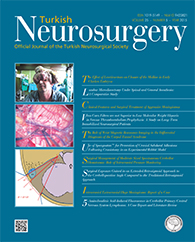MATERIAL and METHODS: From 2005 to 2011, 13 patients accepting DC under the diagnosis of malignant cerebral infarction were retrospectively evaluated in terms of ventricular frontal horn dilatation and level of consciousness, Glasgow Coma Scale score, at four different clinical stages: 1): pre-DC stage; 2): post-DC stage while stabilization; 3): post-cranioplasty stage; 4): post-shunt stage [for those with permanent cerebrospinal fluid (CSF) diversion].
RESULTS: All 13 patients had ventricular dilatation and two of them had extra-axial CSF collection. Restoration of ventricular dilatation was not observed in all patients after bone flap placement, but extra-axial CSF collection resorbed spontaneously. Four patients accepting permanent CSF diversion had no improvement over neurological expression. Otherwise, two of them complicated with subdural effusion after shunt placement.
CONCLUSION: Decompressive craniectomy itself would lead to ventricular dilatation universally. There is no direct association between degree of ventriculomegaly and neurological expression. Permanent CSF diversion surgery as treatment for ventriculomegaly makes no clinical improvement with possible complications of overshunting.
Keywords : Decompressive craniectomy, Hydrocephalus, Ventriculomegaly




